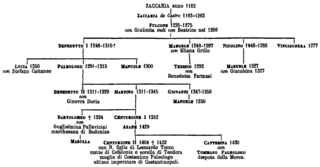Chiara Zorzi or Giorgio, also Clara or Claire, was duchess consort of Athens by marriage to Nerio II Acciaioli, Duke of Athens, and regent of Athens during the minority of her son Francesco I from 1451 until 1454.
The margraviate or marquisate of Bodonitsa, today Mendenitsa, Phthiotis, was a Frankish state in Greece following the conquests of the Fourth Crusade. It was originally granted as a margravial holding of Guy Pallavicini by Boniface, first king of Thessalonica, in 1204. Its original purpose was to guard the pass of Thermopylae.
Francis Zorzi (1337–1388), called Marchesotto, was a member of the Venetian Zorzi family and the Marquess of Bodonitsa in Central Greece from 1345 to his death.
Nicholas II Zorzi or Giorgi was the Margrave of Bodonitsa, a member of the Zorzi family of the Republic of Venice, from 1410 to 1414. He was the last Venetian margrave to actually rule before the Ottoman Turkish conquest.
Nicholas ΙΙΙ Zorzi or Giorgi was the Marquess of Bodonitsa, a member of the Zorzi family of the Republic of Venice, from 1416 to 1436, though the title was purely nominal by then. Before becoming marquess in an exchange with his nephew Nicholas II, he was the baron of Carystus. He was a son of Guglielma Pallavicini and Marquess Nicholas I Zorzi.
Nicholas I Zorzi was a Marquess of Bodonitsa, and the first member of the Zorzi family of Venice to hold the post, from 1335 to his death. In 1335, he married Guglielma Pallavicini, heiress of Bodonitsa and widow of Bartolommeo Zaccaria.
Guy or Guido Pallavicini, called Marchesopoulo by his Greek subjects, was the first marquess of Bodonitsa in Frankish Greece from 1204 to his death in or shortly after 1237. He was one of the most important Frankish rulers in Greece, and played a major role in the short-lived Kingdom of Thessalonica: in 1208–1209 he supported the Lombard rebellion against King Demetrius of Montferrat, but by 1221 he was the kingdom's regent (bailli), and was left to defend the city against the ruler of Epirus, Theodore Komnenos Doukas. Left unsupported by the Latin Empire, and with a projected crusade to relieve the city delayed, he surrendered the city in December 1224. The belated arrival of the crusade helped to save his own fief from falling to the Epirotes, however, and he was soon able to return there, dying on or shortly after 1237.
UbertinoPallavicini was the son and successor of Guy as Marquess of Bodonitsa in 1237.

The House of Pallavicini, also known as Pallavicino and formerly known as Pelavicino, is an ancient Italian noble family founded by Oberto II Pelavicino of the Frankish Obertenghi family.
Isabella Pallavicini, sometimes Jezebel, was sovereign marchioness of Bodonitsa from 1278 to 1286.
Thomas Pallavicini was the marquess of Bodonitsa following a disputed succession in 1286. He was the grandson of Rubino, younger brother of Guy, the first margrave.
Albert Pallavicini was the fifth marquess of Bodonitsa from his father's death until his own in 1311. His father was Thomas, a great-nephew of the first marquess, Guy. Albert married Maria dalle Carceri, a Venetian noblewoman from Euboea. He even obtained a sixth of that island.

Anthony le Flamenc was an early 14th-century Frankish knight and lord of Karditsa in the region of Boeotia, in the Duchy of Athens.
Maria dalle Carceri was sovereign marchioness of Bodonitsa from 1311 until 1323. She succeeded her late spouse Albert Pallavicini on his death in 1311. While she avoided submitting her principality to the Catalan Company, she could not avoid paying an annual tribute of four destriers.
Andrea Cornaro of the House of Cornaro, was a Venetian citizen from Crete, and baron of Scarpanto. He was the husband of Maria dalle Carceri, heiress of a sixth of Euboea and widow of Albert Pallavicini, and co-governed her half of the marquisate of Bodonitsa until his death.

Humbert II de la Tour-du-Pin was the Dauphin of the Viennois from 1333 to 16 July 1349. Humbert was the last dauphin before the title went to the French crown, to be bestowed on the heir apparent.

BartolomeoZaccaria was the first husband of Guglielma Pallavicini and thus Marquess of Bodonitsa in her right. He also carried the title Lord of Damala during his lifetime.
Jacob Zorzi was the Marquess of Bodonitsa from 1388 to 1410. He was the last true ruler of the Frankish state of Bodonitsa.

The Frankokratia, also known as Latinokratia and, for the Venetian domains, Venetokratia or Enetokratia, was the period in Greek history after the Fourth Crusade (1204), when a number of primarily French and Italian states were established by the Partitio terrarum imperii Romaniae on the territory of the dissolved Byzantine Empire.

Mendenitsa, in the Middle Ages known as Mountonitsa (Μουντονίτσα) and Bodonitsa or Vodonitsa (Βοδονίτσα), is a village in Phthiotis, Greece. Along with the nearby village of Karavidia, it forms a community in the municipal unit of Molos.






